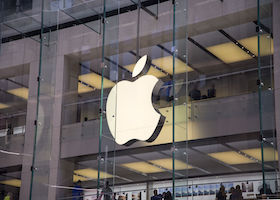Apple (AAPL) became a $1 trillion company in August 2018, and two years later—August 19, 2020—became the first company to be valued at $2 trillion.
Then, the tech giant started out 2022 with a bang. On Monday, January 3, AAPL shares rose by 3% intraday, taking it past the latest milestone—$3 trillion.
Apple had briefly lost its crown as the world’s most valuable company to Microsoft (MSFT) at the end of October 2021. But a strong rally since November restored its crown: its stock has added half a trillion dollars to its market value since November 15.

The only other companies in the world worth more than a trillion dollars include Tesla (TSLA), Amazon (AMZN), Google parent Alphabet (GOOGL), oil group Saudi Aramco, and the aforementioned Microsoft, whose market value is about $2.5 trillion.
Why Apple Is Rising
There are several factors behind Apple’s stock increase since mid-November.
First, Moody’s upgraded Apple to a triple-A rating in December, making it only the third triple-A company assessed by the rating agency, alongside Microsoft and Johnson & Johnson (JNJ). S&P Global still rates Apple at double-A plus, one notch below triple-A…but an upgrade would not surprise.
Another consideration for Apple’s stock performance—up more than 30% in 2021—is that the company managed to navigate the ongoing supply chain crisis better than most companies.
For example, despite the semiconductor shortage, iPhone sales grew 39% in Apple’s latest quarter. Part of that was due to China: according to Counterpoint Research, Apple topped Vivo to become the number-one smartphone brand in China in October and November of last year.
Also helping was the continued talk that Apple would enter the car market. Apple would not build a car, but rather the company would be involved in car interiors. What this would look like is not yet clear, but perhaps it would involve projecting augmented and virtual reality into the windows.
Speaking of AR and VR, Apple stock jumped early in December after Morgan Stanley increased its 12-month price target on Apple to $200. The reason it gave was that investors had not yet priced in the expected launch of augmented and virtual reality devices.
Finally, there is the change brought about by Tim Cook. The CEO moved the company away from a reliance on the iPhone replacement cycle and more toward high-margin services businesses, with recurring revenue streams.
Apple has 745 million paying subscribers to its growing array of services that include music streaming, on-demand video, and fitness and health services. Its wearables business is now a $38 billion annual business, accounting for about 10.5% of sales.
In the past year, Apple’s services business accounted for almost $70 billion of revenue. That number has doubled from just four years ago! And according to Evercore ISI research, in the previous quarter, margins at Apple’s services unit reached a record of 70.5%, which is more than double the margin on hardware sales.
But of course, the question for investors is whether Apple can keep this up. And it sure looks like it can, with its new product pipeline.
Apple’s Future and the Metaverse
This year, Apple is expected to release its first augmented/artificial reality headset. The tech world is buzzing with all sorts of rumors about it, including speculation that Apple’s headset will come with two displays (one for each eye) and could use an advanced array of cameras and sensors.
Sony (SONY) recently unveiled a 4K MicroLED display aimed at virtual reality usage with a roughly 4,000 pixels-per-inch (PPI) resolution. It’s very possible this display was made for Apple’s headset. If we go on the assumption the headset screen array will be 4,000 pixels by 4,000 pixels, the display could measure 1.4 inches across.
A recent rumor about the anticipated Apple headset is even more exciting: that it will incorporate three display modules, comprising two MicroLED panels and one AMOLED (active-matrix light-emitting diodes) display. The expected price tag? From $1,000 to $3,000—a premium price, like all of Apple’s products. Whatever Apple comes up with for its AR/VR headset for the metaverse, I suspect a $4 trillion valuation could already be on the horizon.





